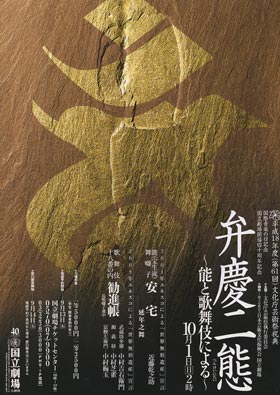| OCTOBER 2006 |
|
2 shows in Nagoya (Misonoza), 4 in T˘ky˘ (Kabukiza, National Theatre, NHK Hall) and 1 in ďsaka (Sh˘chikuza)!
|
| Misonoza (Nagoya) |  |
| Dates | 1 ~ 25 October 2006 (Kichirei Kaomise K˘gy˘ Kabuki) |
| MatinÚe | |
| Evening | |
| Casting |
Sakata T˘jűr˘, Onoe Kikugor˘, Nakamura Tokiz˘, Band˘ Mitsugor˘, Nakamura Jakuemon, Kataoka Gat˘, Kataoka Hidetar˘, Ichikawa Sadanji, Nakamura Kanjaku, Nakamura Senjaku, Kataoka Takatar˘, Ichikawa Danz˘, Onoe Sh˘roku, Band˘ Takesabur˘, Nakamura Kikaku, ďtani Tomoemon, Ichikawa Unosuke, Band˘ Shűch˘, Kataoka Kamez˘, Band˘ Kamesabur˘, Kataoka Shinnosuke |
| Comments |
The first kaomise of the year. Sakata T˘jűr˘ celebrates his shűmei at the Misonoza by playing the roles of Sasaki Moritsuna and the keisei Yayoi (in reality the spirit of a shishi) in the drama "ďmi Genji Senjin Yakata" and the dance "Makura Jishi".
|
| Kabukiza (T˘ky˘) |  |
| Dates | 2 ~ 26 October 2006 (Geijutsusai Jűgatsu ďkabuki) |
| MatinÚe |
Ashiya D˘man ďuchi Kagami (Kuzu-no-Ha) |
| Evening |
|
| Casting |
Kataoka Nizaemon, Matsumoto K˘shir˘, Ichikawa Danjűr˘, Nakamura Shikan, Nakamura Kaishun, Ichikawa Danshir˘, Onoe Kikunosuke, Ichikawa Ebiz˘, Ichikawa Monnosuke, Band˘ Yajűr˘, Ichikawa Komaz˘, Kawarasaki Gonjűr˘ |
| Comments |
|
| National Theatre (T˘ky˘) |
| Dates | 1 October 2006 |
| Program |
Benkei Nitai
|
| Casting |
Kond˘ Kennosuke, Nakamura Kichiemon, Nakamura Baigyoku, Nakamura Shibajaku |
| Comments |
A great and unusual program dedicated to the monk warrior Benkei. The first item is the famous N˘ drama "Ataka" and the second one is "Kanjinch˘", the Kabuki adaptation of this N˘ drama, most likely the most famous dance-drama in the current Kabuki repertoire. The role of Benkei is performed by Kond˘ Kennosuke of the H˘sh˘ school in "Ataka" and by Nakamura Kichiemon in "Kanjinch˘". |
|
The poster of the October dual program at the National Theatre |
|
| National Theatre (T˘ky˘) |
| Dates | 4 ~ 27 October 2006 |
| Program |
|
| Casting |
Nakamura Kichiemon, Nakamura Tomijűr˘, Nakamura Baigyoku, Nakamura Shibajaku, Band˘ Hikosabur˘, Nakamura Karoku, Nakamura Kash˘, Nakamura T˘z˘, Nakamura Shinjir˘, Kataoka Roen, Nakamura Matsue, Band˘ Kametoshi, ďtani Keiz˘, Sawamura Yoshijir˘, Nakamura Tanetar˘, Nakamura Hayato |
| Comments |
The National Theatre commemorates its 40th anniversary. Mayama Seika's Shinkabuki masterpiece "Genroku Chűshingura" is staged in its integrity over 3 months in 3 different productions with 3 different stars in the leading role of ďishi Kuranosuke. This month, the role is played by Nakamura Kichiemon. |
| Sh˘chikuza (ďsaka) |
| Dates | 2 ~ 26 October 2006 (Jűgatsu Hanagata Kabuki) |
| Program |
Somemoy˘ Chűgi no Goshuin |
| Casting |
Ichikawa Danjir˘, Ichikawa Somegor˘, Kataoka Ainosuke, Ichikawa Shun'en, Ichikawa En'ya, Ichikawa Juen, Band˘ Shinsha, Kamimura Kichiya |
| Comments |
Rare revival of Kawatake Shinshichi III's drama "Somemoy˘ Chűgi no Goshuin", which was premiered in November 1889 at the Ichimuraza. Real fire was used on stage for the premiere of this play mixing revenge and homosexuality. This revival in ďsaka features Ichikawa Somegor˘, Kataoka Ainosuke and Ichikawa Danjir˘ in the roles of ďkawa Tomoemon, Innami Kazuma and Hosokawa Ecchű-no-Kami (kami of the province of Ecchű).
|
| NHK Hall (T˘ky˘) | |
| Dates | 29 October 2006 (Koten Gein˘ Kansh˘ Kai) |
| Program | |
| Casting |
Onoe Kikugor˘, Nakamura Tokiz˘, Band˘ Mitsugor˘, Onoe Kikunosuke, Ichikawa Danz˘, Band˘ Shűch˘, Kawarasaki Gonjűr˘, Ichimura Manjir˘, Kataoka Kamez˘, Ichikawa Omez˘, Onoe Ukon, Onoe Matsuya |
| Comments |
33rd edition of Koten Gein˘ Kansh˘ Kai (literally the "Classics Entertainment Appreciation Association"), a yearly performance produced by the National TV network NHK. The program includes one ky˘gen, one Kabuki play, one traditional dance and traditional music. |
|
|
| Contact | Main | Top | Updates | Actors | Plays | Playwrights | Programs | Links | FAQ | Glossary | Chronology | Illustrations | Prints | Characters | Derivatives | Theaters | Coming soon | News |
